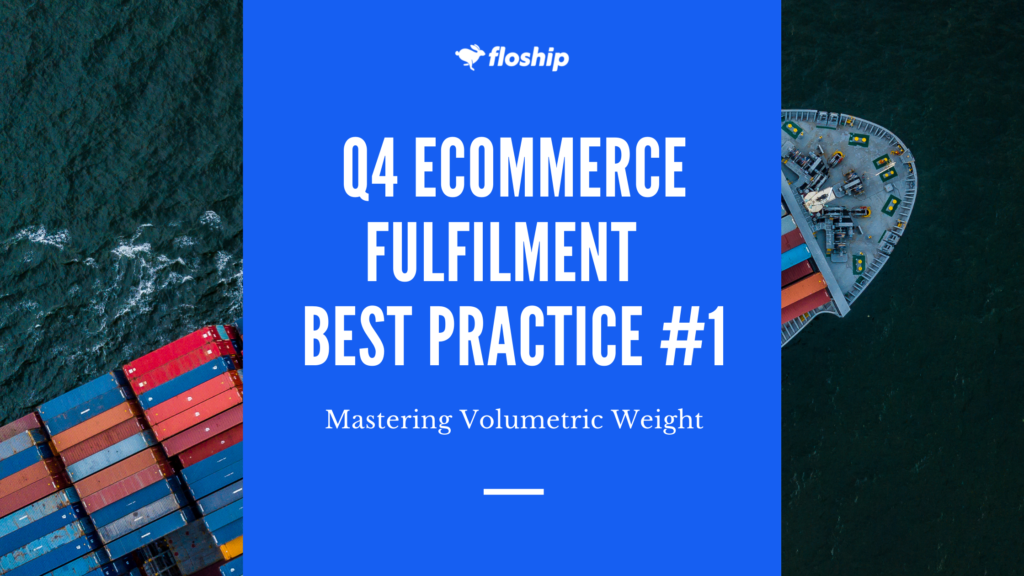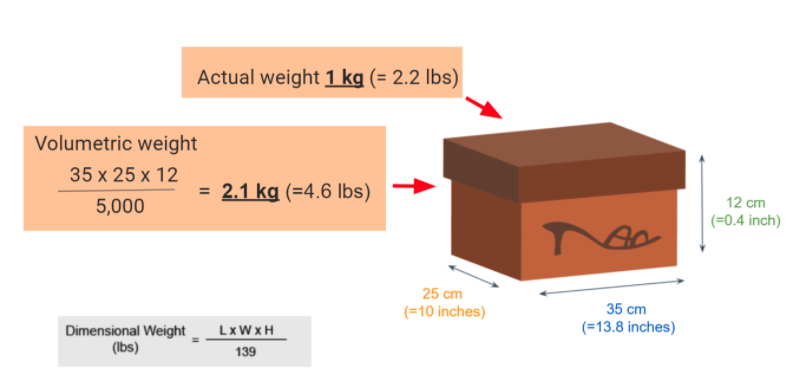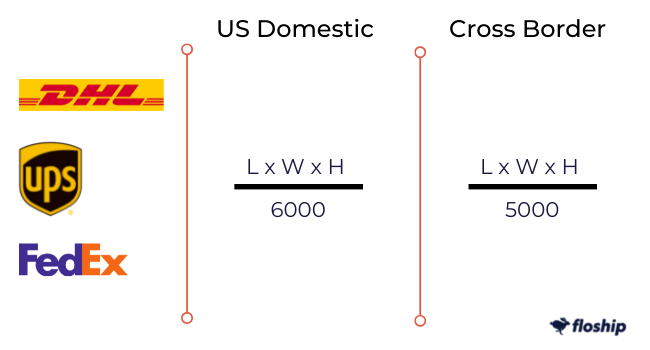As you are aware now, shipping container and air freight costs are going through the roof this time of the year. Having your customers complete the checkout process now brings the daunting task of maintaining the holistic customer experience that takes root online and culminates with the parcel in the hands of the buyer, fast and hassle free. Therein lies the challenge.
Domestically, US shoppers have been spoiled by Amazon Prime’s delivery SOPs on both counts of price and time. Conversely, when it comes to cross border shipping, there are many variables whose levers affect both the shipping rate and cost.
Today, we will deep dive into mastering the key variable that affects all cross border shippers, independent of destination or carrier selection – volumetric weight
WHAT IS VOLUMETRIC WEIGHT?
Volumetric weight, also known as dimensional weight, is the package weight as calculated by the carrier, while the gross weight is the actual weight of the package when you physically place it on a weighing machine or scale.
The higher number between volumetric and gross weight is the weight carriers will charge for your parcel. This number is called the chargeable weight.
The reason behind this practice is lies behind the mantra that space is king in the carrier world.
The best way to maximize carrier profits is by charging transportation cost based on the surface occupied by the package and not the actual weight. For example, cotton wool can be lightweight but occupy a bigger surface area. Compare this to metal bars that occupy a smaller surface area but can be significantly heavier. To this effect, to have your cake and eat it too, carriers choose the higher number between volumetric weight and actual weight as their chargeable weight.
How does this influence your decision-making? Choosing the right carrier for your cross border shipping will have significant impact on your operational costs and goes a long way to increase your profit margins.
HOW CARRIERS CALCULATE CHARGEABLE WEIGHT
In logistics, space & volume is king. A carrier’s profitability is maximized when they are able to stack as many orders as possible into a shipping container or air cargo space.
The formula for calculating the volumetric weight of an item is to take the item’s volume and divide it by a divisor.
Where volume = (Length x Width x Height) dimensions of the item, and the constant being 5,000 for US domestic shipping and 6,000 for cross border shipping,
That said, when analyzing the three major global carriers UPS, FedEx, and DHL. Their cargo carrier and global network dominance makes them reliable shipping partners for ecommerce brands exploring express delivery shipping options. However, as we discussed, each carrier has their own divisor and that number ultimately effects the billable weight and consequentially, the cost of your shipping, let’s do a deeper dive on each carrier, for the purpose of this article and quite relevant in the current Q4 shipping environment, we will only dissect how they calculate express shipping:
1. United Parcel Service (UPS)
For cross border UPS determines the volumetric weight in in centimetre and then divide it by its divisor 5,000. However to complicate the process, UPS can also calculate cubic size (L x W x H) in inches and then has a variable divisor that is 139 for daily rates and 166 for retail rates.
Ultimately, the billable weight is determined by comparing the package’s actual weight to its volumetric weight. The higher of the two weights becomes your chargeable weight.
2. FedEx
FedEx uses the same formula as UPS to determine the volumetric weight—L x W x H, in centimetre. The Fedex divisor is 5,000. The complete formula is: Volumetric weight = (L x W x H)/5000 and is applicable for shipments to Europe, Middle East, Africa, and the Indian Sub-continent. Like UPS, the chargeable weight is the higher of volumetric and actual weight.
3. DHL
DHL runs multiple volumetric weight model. The base model is (L x W x H)/5000. However, when you dig deeper, they have determined the chargeable weight based on the product being an export or import.
Export billable weight is calculated in inches & pound and divided DHL’s divisor 138.4. The volumetric weight is then rounded up to the next half number, i.e. 14.4 to 15 lbs. The billable weight should be the higher weight between the actual and volumetric weight.
Billable weight for imports is calculated in centimeter & kilogram and dividing it by 5,000–(L x W x H)/5,000). Lastly, round the result off to the nearest half number, i.e., 13.4 to 13.5 kgs.
AFFECT OF VOLUMETRIC WEIGHT ON YOUR ECOMMERCE BRAND
Determining the best volumetric weight is a balance of two factors: product protections vs shipping cost.
It is imperative that all ecommerce brands ship items safely, especially delicate products. However, that is done in the background of ensuring the cost of protection from the packaging is balanced against the incremental increase in shipping cost.
Therefore, choosing the best fit packaging is critical to balance protection vs. volumetric weight. Below, we will show you how 3PLs who specialise in ecommerce fulfillment can help you successfully juggle cost and protection
HOW 3PLS CAN HELP SAVE ON VOLUMETRIC WEIGHT
The key benefit of using third-party logistic services is shipping cost-saving . Below is how partnering with a 3PL can optimise your shipping costs through both their carrier relationships and expertise in minimising the volumetric weight without compromising on the product’s packaging safety.
- You will be able to find the best rates through a 3PL based on 2 criterias, 1 is the range and variety of carrier companies they work with and 2 is the total volume that you ship out a monthly basis. As we discussed earlier in the article, space and volume are the ultimate deciders behind the quoted carrier price, the more volumes your brand transacts on a monthly basis, the more competitive the shipping rates.
- Packaging Optimization: As this article suggests, the key to reducing the shipping is to customise the packaging based on the the SKUs your brand transacts. The common mistake that 3PLs make is a one size fits all packaging solution regardless of the number of SKUs per order. A common solution Floship provides to all our clients is to match your most ordered SKU batches with customised packaging created to reduce the volumetric weight and hence, the shipping cost.
- Plan out your delivery shipping warehouse by shipping from warehouse locations closest to the geographic region your customer is in. This is the adoption of a closest to customer warehouse strategy that moves your inventory into warehouse locations near your customers. To enable this functionality, you need to work with a 3PL with warehouses across multiple geographic regions
HOW FLOSHIP CAN HELP
We get it, cross border fulfillment involves mastering the many variables that when combined, lead to a shipping cost and delivery time that aims to improve your shopping cart checkout rate.
When we break this down further, packaging optimization is pivotal to managing your volumetric weight. This is where Floship’s consulting takes the spotlight in not only understanding your key SKU order profiles but work with you to create the optimal packaging that protects your product and minimize the volumetric weight.
If you like to find out more, get in touch with a Floship consultant today.

Ready To Upgrade Your Logistic Solution?
Speak to Floship ecommerce logistic consultant about improving your global support chain today






